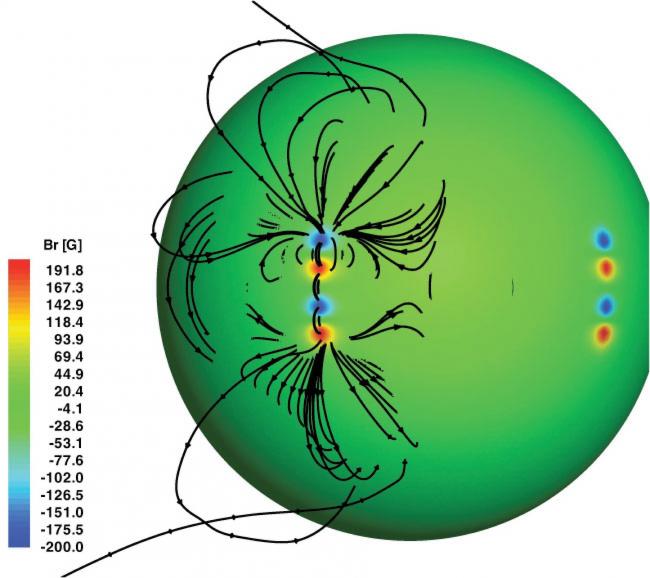
Astronomers have successfully modeled how certain properties of magnetic fields (shown as dark lines) from sunspots (colored areas) vary with the latitude of the spots on a star's surface, and calculated the effects of these fields on the star's wind and rate of rotation.
Stars spin. The sun, for example, takes about twenty-five days to rotate, as can be seen by watching its dark sunspots move across the disk. Winds from stars, the sun included, play a role in slowing down this spin, a feature of winds that is perhaps less dramatic than its blowing of charged particles into space, but which is no less important because both winds and spin affect a star's evolution. All this happens largely because of a star's magnetic fields. The fields help to power the wind of a star, but as the fields loop and twist from the surface through the hot corona out into the extended stellar atmosphere, they also play a role in the dragging, or braking, of the stellar rotation. Those dark sunspots are precisely the places where the sun's magnetic fields are most active, and they significantly modify the magnetic field and wind structure responsible for the dragging. At least this is what astronomers think, based on approximate models that treat the stellar surface as a symmetrical body.
CfA astronomers Ofer Cohen, Jeremy Drake, and Vinay Kashyap, with a colleague, have just published a new study of stellar winds, magnetic fields, and braking. They extend the current models by introducing a realistic model that for the first time calculates the effects of the irregular locations of sunspots - some near the stellar equator, while others closer to the poles. Their results find that a spot's location significantly affects the large-scale structure of the wind and the relationships between these various factors of magnetic fields, braking, and wind properties. The new results are significant because by using more realistic models they help to clarify how magnetic fields slow down a stars' spin. In particular, they find that the spin-down is greater from spots located in the polar regions.